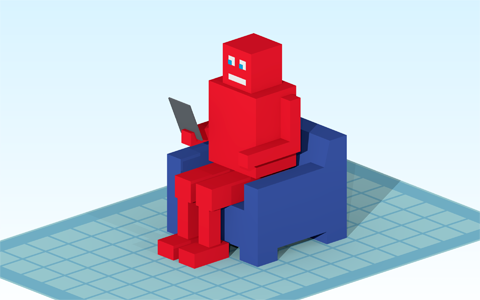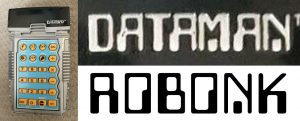The software that builds Robonk has been significantly retooled for the next 256 strips. Lots of changes have happened. The rendering of the robot has become more rich, the robot has changed ever so slightly (and gained a new rug), panels are generated entirely in a new version of Bubblematic called Panelmatic (plus Titlematic for generating the title pages), the dating profile database has been reloaded, and there’s mild improvements for the script generation system.
New look and software

New robot rendering
The robot views are now rendered in POV-Ray, a “high-quality, Free Software tool for creating stunning three-dimensional graphics”. POV-Ray allows for a series of still images to be rendered with lighting effects. Being a command line tool that accepts options arguments, I was able to use PHP-CLI to call for the full series of angles and facial expressions needed to generate the panels for the strip.
Slightly modified robot with a new rug
Robonk (the robot) looks about the same, but there are changes:
- The tablet was shortened. It cuts less through the robot’s arm than before.
- The mouth and eye whites have been mildly moved from where they were. The eyeballs still stick out.
- Tiny changes to body element sizes.
The biggest change is the new rug. Before, it was the workplane in TinkerCAD, and now it’s an “actual” drawn rug.
Panelmatic/Titlematic
- Main Panels: Originally, the panels were composed in Photoshop with screenshots from TinkerCAD (strips #00000-#000FF). Later (strips #00100-#001FF), strips were created from Bubblematic (which drew the talk bubbles and fade background) and TinkerCAD (robot, chair, and rug) then merged together in Photoshop. The main panels are now generated in a browser-based program called Panelmatic (which was created from the older Bubblematic).
 Title Panels: Title panels were originally made in Photoshop, using an action to scale and rotate the text on the robot’s tablet for each strip. Now, this is all done via Titlematic, a new tool using a web browser to generate the title panels. The title font for the strip was changed (with inspiration from the Texas Instruments Dataman educational calculator from 1977), the tablet has a new font, and the scene uses a different angle plus updated graphics from POV-Ray.
Title Panels: Title panels were originally made in Photoshop, using an action to scale and rotate the text on the robot’s tablet for each strip. Now, this is all done via Titlematic, a new tool using a web browser to generate the title panels. The title font for the strip was changed (with inspiration from the Texas Instruments Dataman educational calculator from 1977), the tablet has a new font, and the scene uses a different angle plus updated graphics from POV-Ray.
The biggest change with all of this is that Photoshop and TinkerCAD are no longer needed to generate a comic strip. A big savings in creation time while having an improved look. Using Titlematic is a multiplier (maybe 5x) faster than using Photoshop. Panelmatic also saves a significant amount of time while creating a nicer looping strip, though a chunk of those gains existed with the predecessor (Bubblematic).
Dating profile database reload
The database load was dirty (beyond just the content in the tables) and there was missing data. Everything was rebuilt/reloaded and now there’s more available profiles to draw from, and they’re more complete as well. The next set of strips (#00200-#002FF) will have more usernames on the title panels by percentage than before because the database is more complete.
Script generation
Behind the scenes, the script generation system Robonkers has seen mild improvements, which make everything easier to work with. It rejects a higher percentage of profiles compared to the earlier versions, but there’s more overall profiles to work with because the database reload increased the overall amount of accessible profiles. The character name for the human in the source dialogue is now “human:” rather than “you:”.
In conclusion
Robonk is ready to go for another 256 strips, and this will be the basis for the next 256.
